浅析英语诗歌语法[二]——句法上篇下篇
- 格式:doc
- 大小:28.00 KB
- 文档页数:15
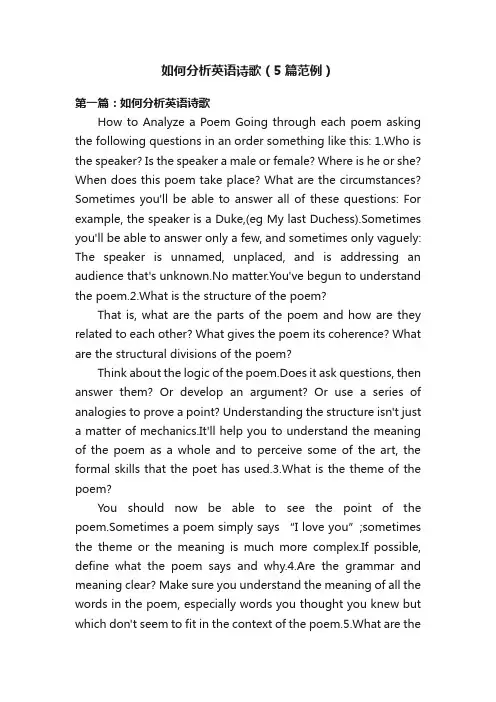
如何分析英语诗歌(5篇范例)第一篇:如何分析英语诗歌How to Analyze a Poem Going through each poem asking the following questions in an order something like this: 1.Who is the speaker? Is the speaker a male or female? Where is he or she? When does this poem take place? What are the circumstances? Sometimes you'll be able to answer all of these questions: For example, the speaker is a Duke,(eg My last Duchess).Sometimes you'll be able to answer only a few, and sometimes only vaguely: The speaker is unnamed, unplaced, and is addressing an audience that's unknown.No matter.You've begun to understand the poem.2.What is the structure of the poem?That is, what are the parts of the poem and how are they related to each other? What gives the poem its coherence? What are the structural divisions of the poem?Think about the logic of the poem.Does it ask questions, then answer them? Or develop an argument? Or use a series of analogies to prove a point? Understanding the structure isn't just a matter of mechanics.It'll help you to understand the meaning of the poem as a whole and to perceive some of the art, the formal skills that the poet has used.3.What is the theme of the poem?You should now be able to see the point of the poem.Sometimes a poem simply says “I love you”;sometimes the theme or the meaning is much more complex.If possible, define what the poem says and why.4.Are the grammar and meaning clear? Make sure you understand the meaning of all the words in the poem, especially words you thought you knew but which don't seem to fit in the context of the poem.5.What are theimportant images and figures of speech?What are the important literal sensory objects, the images, such as a field of poppies or a stench of corruption? What are the similes and metaphors of the poem? In each, exactly what is compared to what? The most difficult challenge of reading poetry is discriminating between the figurative and the literal.6.What is the tone of the poem?Tone can mean a manner of speaking, a tone of voice.But its most common use as a term of literary analysis is to denote the inferred attitude of an author.When the author's attitude is different from that of the speaker, as is usually the case in ironic works, the tone of voice of the speaker, which may be calm, businesslike, even gracious, may be very different from the satiric tone of the work, which reflects the author's disapproval of the speaker.7.What literary devices does the poem employ?The list of rhetorical devices that a writer may use is enormous.The terms you should worry about are, above all, metaphor, simile, and personification.8.What is metrical pattern of the poem?Read the poem out loud and note the rhyme, meter, and sound effects.How do they contribute to the overall tone of the work?第二篇:英语诗歌精选导语:慢慢品读英语诗歌,感受诗歌的魅力。

英诗的语法特点英文诗的选词造句,即所谓的诗歌语言(Poetic diction)和散文里的有所不同。
虽然诗的语法特点(Poetic License)严格讲起来并不包括在诗的格律范围之内,但和格律有着密不可分的联系,有些还是专门为了适应格律的要求,所以这里有加以简单介绍的必要,而且这对理解诗意也会有所帮助。
英诗的语法特点概括起来有几个方面值得介绍一下:§l 使用废字和不常见字前人用过的有些英文字早已为时代所淘汰,成为废字和不常见词(archaic or less common words)在日常生活和散文里,已经没有人再用或很少使用,而在诗里却屡见不鲜。
这可能是由于这些词古色古香,能触发诗人的情思,发思古之幽情,也许是诗歌中用些古词显得高雅,吸引读者注意,主要还是诗歌多注重言外之意,对于口语文字的时代变化不太注意。
举例说明如下:(一)名词:诗歌里常用swine代替pigs, swain 代替农民。
Spouse 代替wife. Steed 代替horse, main代替sea. damsel代替girl.(二) 代词:诗歌里常用thou和thee, 分别代替you的主格和宾格。
Ye和you代替复数主格。
Thy或thine(首字母为元音的名词前)代替your的单数, thine代替yours; mine 代替my.(三) 形容词:诗里常用lowly代替humble (卑贱的);ingrate代替ungrateful (忘恩负义的), mute代替silent.(沉默的);fond代替foolish(愚蠢的);reckless代督careless,代替careless(轻率的);do1eful代替sorrowful(苦恼的);artless代替innocent(天真的);hapless 代替unluckly(不幸的)。
等等。
(四) 副词:诗里常用hapty代替perhaps(或许);oft代替often(时常);erst代替formerly(从前);anon代替at once(立即);full代替very(很)。
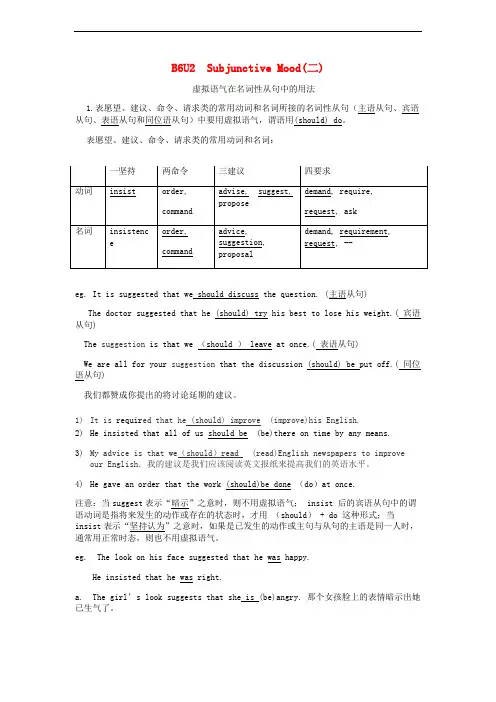
B6U2 Subjunctive Mood(二)虚拟语气在名词性从句中的用法1.表愿望、建议、命令、请求类的常用动词和名词所接的名词性从句(主语从句、宾语从句、表语从句和同位语从句)中要用虚拟语气,谓语用(should) do。
表愿望、建议、命令、请求类的常用动词和名词:eg. It is suggested that we should discuss the question. (主语从句)The doctor suggested that he (should) try his best to lose his weight.( 宾语从句)The suggestion is that we (should ) leave at once.( 表语从句)We are all for your suggestion that the discussion (should) be put off.( 同位语从句)我们都赞成你提出的将讨论延期的建议。
1)It is requir ed that he (should) improve (improve)his English.2)He insisted that all of us should be (be)there on time by any means.3)My advice is that we(should)read (read)English newspapers to improveour English.我的建议是我们应该阅读英文报纸来提高我们的英语水平。
4)He gave an order that the work (should)be done (do)at once.注意:当suggest表示“暗示”之意时,则不用虚拟语气; insist 后的宾语从句中的谓语动词是指将来发生的动作或存在的状态时,才用(should) + do 这种形式;当insist表示“坚持认为”之意时,如果是已发生的动作或主句与从句的主语是同一人时,通常用正常时态,则也不用虚拟语气。

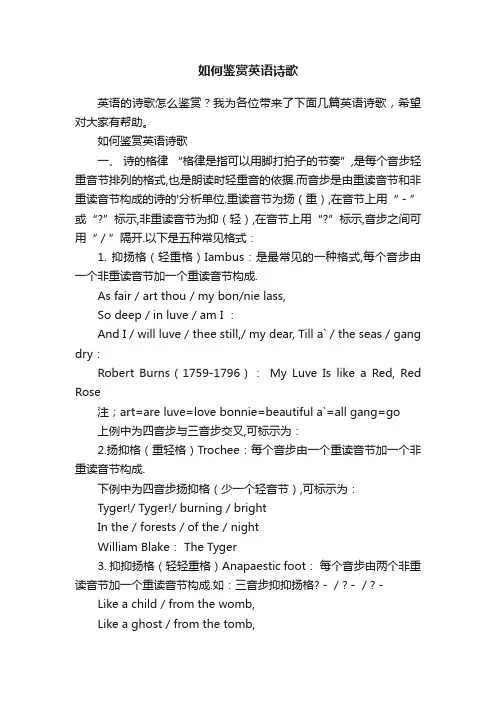
如何鉴赏英语诗歌英语的诗歌怎么鉴赏?我为各位带来了下面几篇英语诗歌,希望对大家有帮助。
如何鉴赏英语诗歌一、诗的格律“格律是指可以用脚打拍子的节奏”,是每个音步轻重音节排列的格式,也是朗读时轻重音的依据.而音步是由重读音节和非重读音节构成的诗的'分析单位.重读音节为扬(重),在音节上用“-”或“?”标示,非重读音节为抑(轻),在音节上用“?”标示,音步之间可用“/”隔开.以下是五种常见格式:1. 抑扬格(轻重格)Iambus:是最常见的一种格式,每个音步由一个非重读音节加一个重读音节构成.As fair / art thou / my bon/nie lass,So deep / in luve / am I :And I / will luve / thee still,/ my dear, Till a` / the seas / gang dry:Robert Burns(1759-1796):My Luve Is like a Red, Red Rose注;art=are luve=love bonnie=beautiful a`=all gang=go上例中为四音步与三音步交叉,可标示为:2.扬抑格(重轻格)Trochee:每个音步由一个重读音节加一个非重读音节构成.下例中为四音步扬抑格(少一个轻音节),可标示为:Tyger!/ Tyger!/ burning / brightIn the / forests / of the / nightWilliam Blake: The Tyger3. 抑抑扬格(轻轻重格)Anapaestic foot:每个音步由两个非重读音节加一个重读音节构成.如:三音步抑抑扬格?-/?-/?-Like a child / from the womb,Like a ghost / from the tomb,I arise / and unbuild / it again.4. 扬抑抑格(重轻轻格)Dactylic foot:每个音步由一个重读音节加两个非重读音节构成.如:两音步扬抑抑格-?/-?Touch her not / ?scornfully,Think of her / ?mournfully.- Thomas Hood5. 抑扬抑格(轻重轻格)Amphibrach:每个音步由一个非重读音节加一个重读音节再加一个非重读音节构成.如:三音步抑扬抑格?-?/?-?/?-?下例中最后一个音步为抑扬格.O ?hush thee / my ?babie / thy ?sire was / a knight.在同一首诗中常会出现不同的格律,格律解析对朗读诗歌有一定参考价值.现代诗中常不遵守规范的格律.二、诗的押韵押韵是指通过重复元音或辅音以达到一定音韵效果的诗歌写作手法.1. 尾韵:最常见,最重要的押韵方式.1)联韵:aabb型.I shot an arrow into the air,It fell to earth, I knew not where;For, so swiftly it flew, the sightCould not follow it in its flight.Henry Wadsworth Longfellow: The Arrow and the Song2)交叉韵:abab型.Sunset and evening star,And one clear call for me!And may there be no moaning of the bar,When I put out to sea,Alfred Tennyson(1809-1892): Crossing the Bar3)同韵:有的诗押韵,一韵到底,大多是在同一节诗中共用一个韵脚.如下例就共用/i:p/为韵脚.The woods are lovely, dark and deep,But I have promises to keep,And miles to go before I sleep,And miles to go before I sleep.Robert Frost (1874-19633):Stopping by Woods on a Snowy Evening2. 头韵:是指一行(节)诗中几个词开头的辅音相同,形成押韵.下例中运用/f/、/b/与/s/头韵生动写出了船在海上轻快航行的景象.The fair breeze blew, the white foam flew,The furrow followed free,We were the first that ever burstInto that silent sea.。
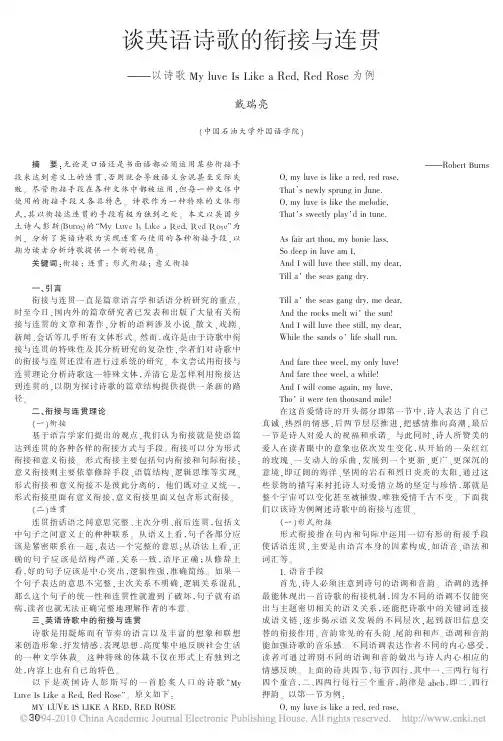
摘要:无论是口语还是书面语都必须运用某些衔接手段来达到意义上的连贯,否则就会导致语义含混甚至交际失败。
尽管衔接手段在各种文体中都被运用,但每一种文体中使用的衔接手段又各具特色。
诗歌作为一种特殊的文体形式,其以衔接达连贯的手段有极为独到之处。
本文以英国乡土诗人彭斯(Burns)的“My Luve Is Like a Red,Red Rose”为例,分析了英语诗歌为实现连贯而使用的各种衔接手段,以期为读者分析诗歌提供一个新的视角。
关键词:衔接;连贯;形式衔接;意义衔接一、引言衔接与连贯一直是篇章语言学和话语分析研究的重点。
时至今日,国内外的篇章研究者已发表和出版了大量有关衔接与连贯的文章和著作,分析的语料涉及小说、散文、戏剧、新闻、会话等几乎所有文体形式。
然而,或许是由于诗歌中衔接与连贯的特殊性及其分析研究的复杂性,学者们对诗歌中的衔接与连贯还没有进行过系统的研究。
本文尝试用衔接与连贯理论分析诗歌这一特殊文体,弄清它是怎样利用衔接达到连贯的,以期为探讨诗歌的篇章结构提供提供一条新的路径。
二、衔接与连贯理论(一)衔接基于语言学家们提出的观点,我们认为衔接就是使语篇达到连贯的各种各样的衔接方式与手段。
衔接可以分为形式衔接和意义衔接。
形式衔接主要包括句内衔接和句际衔接;意义衔接则主要依靠修辞手段、语篇结构、逻辑思维等实现。
形式衔接和意义衔接不是彼此分离的,他们既对立又统一,形式衔接里面有意义衔接,意义衔接里面又包含形式衔接。
(二)连贯连贯指话语之间意思完整、主次分明、前后连贯,包括文中句子之间意义上的种种联系。
从语义上看,句子各部分应该是紧密联系在一起,表达一个完整的意思;从语法上看,正确的句子应该是结构严谨,关系一致,语序正确;从修辞上看,好的句子应该是中心突出,逻辑性强,准确简练。
如果一个句子表达的意思不完整,主次关系不明确,逻辑关系混乱,那么这个句子的统一性和连贯性就遭到了破坏,句子就有语病,读者也就无法正确完整地理解作者的本意。
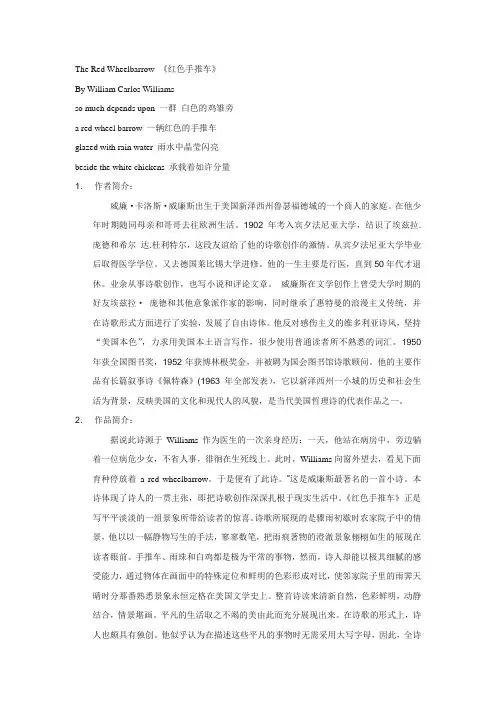
The Red Wheelbarrow 《红色手推车》By William Carlos Williamsso much depends upon一群白色的鸡雏旁a red wheel barrow一辆红色的手推车glazed with rain water雨水中晶莹闪亮beside the white chickens承载着如许分量1.作者简介:威廉·卡洛斯·威廉斯出生于美国新泽西州鲁瑟福德城的一个商人的家庭。
在他少年时期随同母亲和哥哥去往欧洲生活。
1902年考入宾夕法尼亚大学,结识了埃兹拉.庞德和希尔达.杜利特尔,这段友谊给了他的诗歌创作的激情。
从宾夕法尼亚大学毕业后取得医学学位。
又去德国莱比锡大学进修。
他的一生主要是行医,直到50年代才退休。
业余从事诗歌创作,也写小说和评论文章。
威廉斯在文学创作上曾受大学时期的好友埃兹拉·庞德和其他意象派作家的影响,同时继承了惠特曼的浪漫主义传统,并在诗歌形式方面进行了实验,发展了自由诗体。
他反对感伤主义的维多利亚诗风,坚持“美国本色”,力求用美国本土语言写作,很少使用普通读者所不熟悉的词汇。
1950年获全国图书奖,1952年获博林根奖金,并被聘为国会图书馆诗歌顾问。
他的主要作品有长篇叙事诗《佩特森》(1963年全部发表),它以新泽西州一小城的历史和社会生活为背景,反映美国的文化和现代人的风貌,是当代美国哲理诗的代表作品之一。
2.作品简介:据说此诗源于Williams作为医生的一次亲身经历:一天,他站在病房中,旁边躺着一位病危少女,不省人事,徘徊在生死线上。
此时,Williams向窗外望去,看见下面育种停放着a red wheelbarrow。
于是便有了此诗。
”这是威廉斯最著名的一首小诗。
本诗体现了诗人的一贯主张,即把诗歌创作深深扎根于现实生活中。
《红色手推车》正是写平平淡淡的一组景象所带给读者的惊喜。
诗歌所展现的是骤雨初歇时农家院子中的情景,他以以一幅静物写生的手法,寥寥数笔,把雨痕著物的澄澈景象栩栩如生的展现在读者眼前。
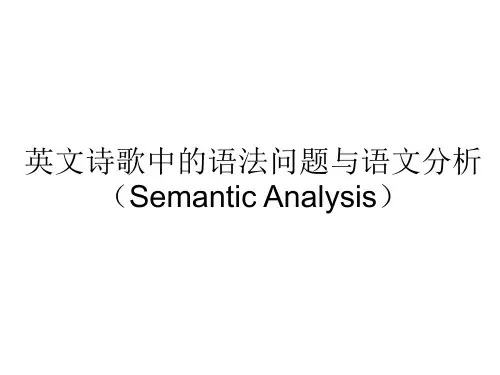
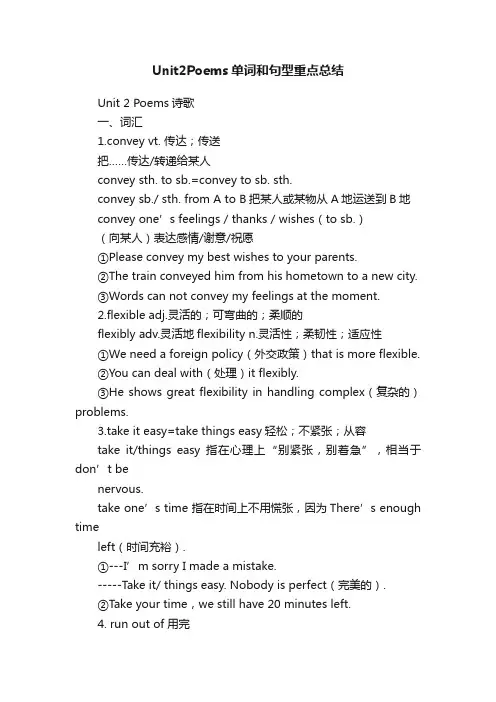
Unit2Poems单词和句型重点总结Unit 2 Poems诗歌一、词汇1.convey vt. 传达;传送把……传达/转递给某人convey sth. to sb.=convey to sb. sth.convey sb./ sth. from A to B把某人或某物从A地运送到B地convey one’s feelings / thanks / wishes(to sb.)(向某人)表达感情/谢意/祝愿①Please convey my best wishes to your parents.②The train conveyed him from his hometown to a new city.③Words can not convey my feelings at the moment.2.flexible adj.灵活的;可弯曲的;柔顺的flexibly adv.灵活地flexibility n.灵活性;柔韧性;适应性①W e need a foreign policy(外交政策)that is more flexible.②You can deal with(处理)it flexibly.③He shows great flexibility in handling complex(复杂的)problems.3.take it easy=take things easy轻松;不紧张;从容take it/things easy 指在心理上“别紧张,别着急”,相当于don’t benervous.take one’s time 指在时间上不用慌张,因为There’s enough timeleft(时间充裕).①---I’m sorry I made a mistake.-----Take it/ things easy. Nobody is perfect(完美的).②Take your time,we still have 20 minutes left.4. run out of 用完run across偶然遇见run into撞上;偶遇;达到run away逃走;溜掉run after追赶run through 快速传遍run over浏览;撞倒并倾轧辨析run out “被用完了”含被动意义,主语通常是时间、金钱、食物等无生命的东西run out of of后接被用完的东西,如money,ink,food,petrol等,其主语为人use up 及物动词短语,其后可接表物的名词作宾语,可用于被动语态give out 作“分发,发出(气味、光、热等)”讲时为及物动词短语;作“用完、耗尽”讲时,为不及物动词短语,不用于被动语态①Tom was running after Jerry when Jerry ran into a person. Both of them ran out of their strength.②I have used up / have run out of my money. Please lend me some. =My money has run out.Please lend me some.5. be made up of由……构成(1)consist of(不用于被动语态和进行时态)由……组成be composed of由……组成(2)make up构成;编造;化妆make up for弥补make out辨认出;理解;领会make for去……,有利于make it获得成功make the most of充分利用①The team is made up of 10 people.=The team is composed of 10 people.=The team consists of 10 people.=10 people make up the team.②H e made up a story for his son.③It took her half an hour to make herself up.④We have to make up for the lost time.⑤I can’t make out your meaning.⑥Running makes for our health.⑦You will make it if you try.⑧We should make the most of the chance.6. tease vi.&vt.取笑;招惹;戏弄tease sb. about sth.因某事而嘲笑某人laugh at嘲笑make fun of取笑make a fool of嘲笑;愚弄play a trick/ tricks on捉弄play a joke/ jokes on开……的玩笑Other boys tease him for his being fat.7. in particular尤其;特别be particular about /over对……挑剔be particular to为……所特有in particular = particularly adv. 尤其;特别①He is particular about what he wears.②As is known to all, pandas are particular to China.③I enjoy this song in particular/ particularly.8. transform vi.&vt.转化;转换;改造;变换transform A into B 使A变成B transform into转化成;改造成transformation n.改变;变革①They have transformed their rooms into a hotel.②The company has been transformed from a family business into a state operation.这家已由家族企业变成一个国家运作机构。
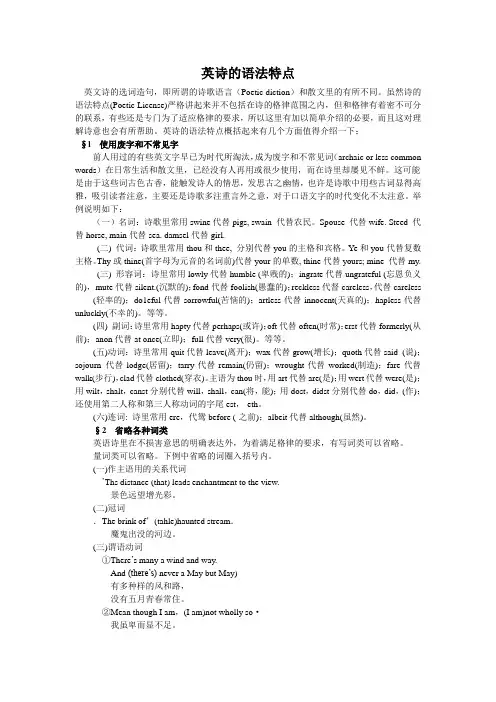
英诗的语法特点英文诗的选词造句,即所谓的诗歌语言(Poetic diction)和散文里的有所不同。
虽然诗的语法特点(Poetic License)严格讲起来并不包括在诗的格律范围之内,但和格律有着密不可分的联系,有些还是专门为了适应格律的要求,所以这里有加以简单介绍的必要,而且这对理解诗意也会有所帮助。
英诗的语法特点概括起来有几个方面值得介绍一下:§l 使用废字和不常见字前人用过的有些英文字早已为时代所淘汰,成为废字和不常见词(archaic or less common words)在日常生活和散文里,已经没有人再用或很少使用,而在诗里却屡见不鲜。
这可能是由于这些词古色古香,能触发诗人的情思,发思古之幽情,也许是诗歌中用些古词显得高雅,吸引读者注意,主要还是诗歌多注重言外之意,对于口语文字的时代变化不太注意。
举例说明如下:(一)名词:诗歌里常用swine代替pigs, swain 代替农民。
Spouse 代替wife. Steed 代替horse, main代替sea. damsel代替girl.(二) 代词:诗歌里常用thou和thee, 分别代替you的主格和宾格。
Ye和you代替复数主格。
Thy或thine(首字母为元音的名词前)代替your的单数, thine代替yours; mine 代替my.(三) 形容词:诗里常用lowly代替humble (卑贱的);ingrate代替ungrateful (忘恩负义的),mute代替silent.(沉默的);fond代替foolish(愚蠢的);reckless代督careless,代替careless (轻率的);do1eful代替sorrowful(苦恼的);artless代替innocent(天真的);hapless代替unluckly(不幸的)。
等等。
(四) 副词:诗里常用hapty代替perhaps(或许);oft代替often(时常);erst代替formerly(从前);anon代替at once(立即);full代替very(很)。
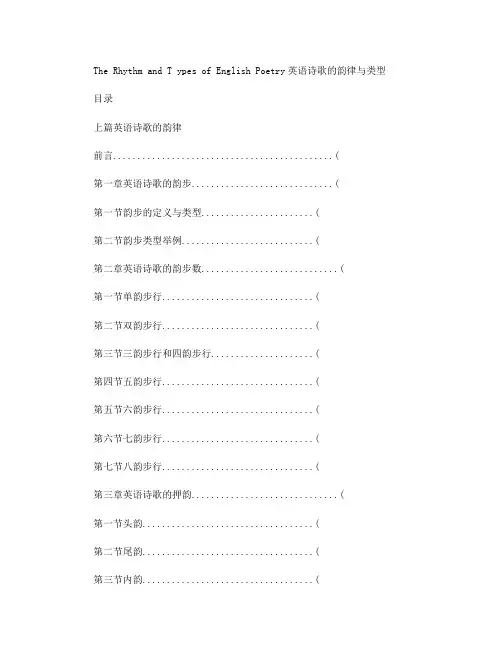
The Rhythm and T ypes of English Poetry英语诗歌的韵律与类型目录上篇英语诗歌的韵律前言.............................................(第一章英语诗歌的韵步.............................(第一节韵步的定义与类型.......................(第二节韵步类型举例...........................(第二章英语诗歌的韵步数............................(第一节单韵步行...............................(第二节双韵步行...............................(第三节三韵步行和四韵步行.....................(第四节五韵步行...............................(第五节六韵步行...............................(第六节七韵步行...............................(第七节八韵步行...............................(第三章英语诗歌的押韵..............................(第一节头韵...................................(第二节尾韵...................................(第三节内韵...................................(第四节元韵...................................(第五节和韵...................................(第六节目韵...................................(第四章英语诗歌的基本押韵格式......................(第一节基本押韵格式...........................(第二节基本押韵格式的组合使用.................(第五章十四行诗的押韵格式.......................(第一节彼特拉克体..........................(第二节莎士比亚体..........................(第三节斯宾塞体............................(第六章诗行与韵律...............................(第一节结句行..............................(第二节连续行..............................(第三节音节增减............................(第四节句式倒装............................(第七章五行打油诗与短回旋诗.....................(第一节五行打油诗..........................(第二节短回旋诗............................(第八章素体诗与自由诗...........................(第一节素体诗..............................(第二节自由诗..............................(下篇英语诗歌的类型第九章叙事诗...................................(第一节史诗.................................(第二节歌谣.................................(第三节戏剧诗...............................(第四节故事诗...............................(第十章抒情诗...................................(第一节颂诗..................................(第二节挽歌..................................(第三节婚庆曲................................(第四节歌..................................(第五节田园短诗............................(第六节田园牧歌............................(第七节爱情小诗............................(第八节哲理诗..............................(第九节宗教诗..............................(第十节赞美诗..............................(第十一节墓志铭.............................(第十二节收场白............................(第十一章融入中国文化的英语诗歌.................(前言《英语诗歌的韵律与类型》是出于教学的需要而编写的。
浅析英语诗歌——结构韵律篇一、诗歌的结构结构主要是指诗的三个主要特点,一是语音组合模式二是口语重音模式三是一定的语体形式诗歌的语音组合模式是指英语诗歌的语音是如何被诗人运用,组合以形成一些常用的或固定的语音模式,如压韵(rhyme),头韵(alliteration),元音韵(assonance),辅音韵(consonance),倒压韵(reverse rhyme),行内韵(internal rhyme)等。
诗歌口语重音模式是指诗人根据单词重音,短语重音,句子重音创造出一定的节奏(rhythm)。
在诗歌中称为格律或韵律(meter)。
格律由音步(foot)构成;英语中的音步有不同类型。
注意:音步指的是一行诗内的节奏,在划分英语诗歌音步的时候我们用这样的标识V \ 来分别标识非重读音节和重读音节,音节的划分主要通过朗读,根据诗的音节为单位划分,而不是整个单词,比如一个英文单词,literature,有四个音节。
扬及重读音节,抑及非重读。
在划分音步的时候要先把一句诗的全部音节划出来,然后按照语义和重音朗读就会得出下面的这几种不同的格律了。
(关于这部分的详细解释和例子请参见英诗解析一文)1. 抑扬格(iamb)由一个非重读音节和一个重读音节组成V \2. 扬抑格(trochee)由一个重读音节和一个非重读音节组成 \ V3. 扬抑抑格(dactyl)由一个重读音节和两个非重读音节组成 \ VV4. 抑抑扬格(anapest)由两个非重读音节和一个重读音节组成 V V \5. 扬扬格(spondee)由两个重读音节构成 \ \6. 抑抑格(pyrrhic)由两个非重读音节构成 V V按音步的多少又可分为:单音步(monometer), 双音步(diameter),三音步(trimeter),四音步(tetrameter),五音步(pentermeter),六音步(hexameter),七音步(heptameter),八音步(octameter)。
英文诗歌欣赏知识第一篇:英文诗歌欣赏知识英文诗歌》英语诗歌的韵律dasha英诗节奏(Rhythm)构成英诗节奏的基础是韵律(metre)。
在希腊语中,“metre”这个字是“尺度(标谁)”的意思。
英诗就是根据诗行中的音节和重读节奏作为“尺度(标准)”来计算韵律的。
英诗的特点之一是与其他文体不同的排列格式。
各诗行不达到每页页边,每行开始词首大写。
几行成为一节(stanza),不分段落。
各行都要讲究一定的音节数量,行末押韵或不押韵,交错排列。
……音节重读(stressed),非重读(unstressed)。
……这就是一种正规的重读形式,在诗歌中即体现为韵律。
研究诗歌韵律规则的科学叫作韵律学(Prosody)。
1.音步(Foot):英诗中这种重读与非重读音节的特殊性组合叫作音步。
一个音步的音节数量可能为两个或三个音节,但不能少于两个或多于三个音节,而且其中只有一个必须重读。
分析英诗的格律就是将它划分成音步,并区分出是何种音步以及计算音步的数量。
这种音步划分叫scansion。
根据一首英诗组成的音步数量,每一诗行一个音步称“单音步”(monometer);每一诗行有两个音步的,称“双音步”(dimeter);含有三个音步的,称“三音步”(trimeter);此外还有四音步(tetrameter)、五音步、(pentameter)、六音步(hexameter)、七音步(heptameter)、八音步(octometer)。
Is this | a fast, | to keqp The lard | or lean And clean?(Herrick)2.韵律(Metre):英诗的韵律是依据音步包含音节的数量及重读音节的位置而加以区分的。
传统英诗的音步有六种:即抑扬格(Lambus)、扬抑格(Trochee)、抑抑扬格(Anapaest)、扬抑抑格(Dactyl)及抑扬抑格(Amphibrach):(Anapaest)、扬抑抑格(Dactyl)及抑扬抑格(Amphibrach):“⌒”非重读音节;“/”重读音节。
浅析英语诗歌语法[一]——词法篇动词1、动词一般现在时第三人称单数的形式是在动词尾加-th,像liv eth,knoweth,hath等等。
如:From her kennel beneath the rockShe maketh answer to the clock. (Coleridge)在她岩石下面的洞穴中,她按照时钟行事。
And in silence prayeth she. (Coleridge)她默默地祈祷。
2、现在时及过去时第二人称单数动词词尾加-st的形式,像livest,knowest,sayst,dost,livedst,knewest,saidst,didst,ha dst等,此外还有动词shall,will, be的形式为shalt,wilt,art(现在时单数第二人称thou art等于you are),wert(或wast,第二人称,单数过去时thou wert或thou wast等于you were)。
上述各种形式均与第二人称单数人称代词thou连用。
如:Nor care what land thou bearst me to.(Byron)我不介意你带我前往何方。
With double joy wert thou with me. (Byron)你与我共享双重欢乐。
Thou liest, thou liest, thou little foot-page,Loud dost thou lie to me! (Scott)你撒谎,你撒谎,你这个小随从,你竟敢明目张胆地对我撒谎!3、过去时和过去分词的较古老形式。
如:wrought (worked), bade (bid), begat (begot), clove (clef t), crew (crowed), drave (drove), spake (spoke), throve (thrived), c lomb (climbed), clad (clothed), bare (bore, “bear”的过去时),br oke (broken), lockt (locked), sate (sat)等。
浅析英语诗歌语法[二]——句法上篇、下篇
浅析英语诗歌语法[二]——句法上篇句法
?
?
词序:为了保持韵律,英诗中的词序与正常词序有所不同。
?
?
?
1、形容词放在所形容的名词之后,而不是在前:
?
?
Daisies pied and violets blue. (Shakespeare) ?
?
色彩斑驳的雏菊和蓝色的紫罗兰。
?
?
So by the caverns of the forest green. (Shelley) ?
?
在青青丛林中的山洞旁。
?
?
With notes angelical to many a harp. (Milton) ?
?
一个又一个竖琴,奏出天使的曲调。
?
?
?
2、主语位于谓语之后:
?
And in silence prayeth she. (Coleridge) ?
?
她默默地祈祷。
?
?
And a wealthy wife was she. (Old Ballad) ?
?
她是富家妇。
?
?
Then came still evening on. (Milton) ?
?
随即黄昏照常来临。
?
?
?
3、直接宾语位于动词之前:
?
?
And she me caught in her arms long and small. (Wyatt) ?
?
她用细长瘦削的胳臂抱住了我。
?
?
Where wine the wit may not oppress. (Howard)
?
?
美酒灌不昏头脑。
?
?
4、前置词在启宾语(名词)之后:?
?
Where echo walks steep hills among. ?
?
回声在陡峭的群山之中回荡。
?
?
?
省略或删节句法中通常需要的字词?
?
?
1、省略冠词:
?
?
Creeping like (a) snail unwillingly to school …?
?
像条蜗牛在爬行,满心不愿意去上学……?
?
2、省略名词或代词:
?
?
(He) who steals my purse steals trash.
?
?
偷我钱包的人一无所得。
?
?
3、省略限定
?
?
动词(finite verb):
?
?
Happy (is) the man, whose wish and care …?
?
这个人非常愉快,他的希望和忧虑……
?
?
4、省略前置词:
?
?
Despair and anguish fled (from) the struggling soul. ?
?
绝望和痛苦离开了挣扎中的灵魂。
?
?
5、省略作附属从句主语的关系代词“that”:?
?
‘Tis distance (that) lends enchantment to the view. ?
?
远则亲。
?
6、省略辅助动词:
?
?
How, why, or when, or where---it matters not. (Shelley) ?
?
怎样,为何,何时或是何地——无关紧要。
?
?
I speak not,,
?
I trace not,
?
I breathe not thy name. (Byron) ?
?
我将从不说起,
?
不追溯。
?
不低声呼叫你的名字。
?
?
?。